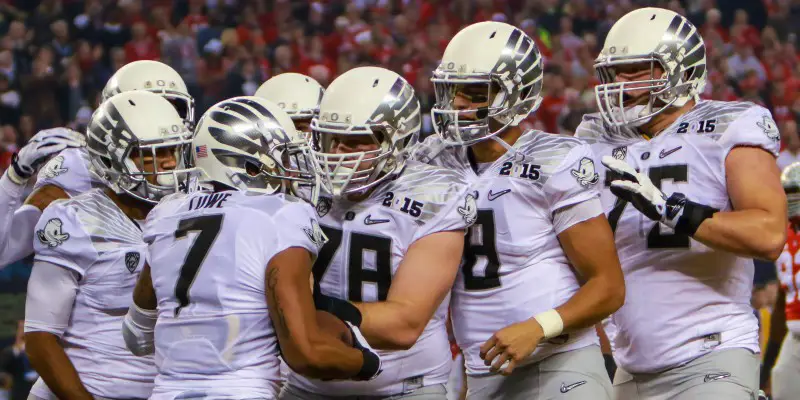(Note from Principal: Before some of you howl, we ARE going to break down what Ohio State did well in the National Championship Game to defeat Oregon. I need a bit more time as I am having several consultation coaches helping me, but in the meantime let’s return to the purpose of the site–and that is to learn. Let’s enjoy Coach Kirby’s analysis of an Oregon touchdown drive! Charles Fischer)
Wouldn’t it be great if coaches had hours instead of seconds to make game-changing decisions? Well it turns out they do.
One of the benefits of creating a list of your opening plays for the first drive of the game is that you’re able to make decisions in your office on a Thursday afternoon instead of reacting to what happens in the game, where you run the risk of letting short-term thinking and emotion cloud your decision-making ability.
In this post, we’re going to break down Oregon’s first drive in the National Championship; we’ll be taking a close look at a couple of plays, including the final scoring play that gave the Ducks a 7-0 lead. We will examine not only the schemes involved in the drive, but also the more subtle aspects of calling plays, what the coaches are looking for, and why they do what they do.
Play #1 – 1st & 10 / -25 / Left Hash
On the first play, you see Oregon line up in a tight 2×2 set, with the receivers squeezed in together, and it’s all about the leverage to the outside. Mariota is looking first to the flat route.
Since the corner starts to sink to the deep third in cover 3, Mariota knows that the OLB to that side is responsible for the flat to the boundary. The OLB in question is walled-off (or picked, depending on your perspective) by the outside receiver going vertical, so the slot receiver will trail him and go underneath to the flat, wide open as you can see on the first play.
The play fake and the threat of the run, even before the ball is snapped, forces the defense to play its LBs so tight, that they cannot afford to cheat and provide extra leverage to the outside of the formation. If you look closely, the two inside linebackers are stacked over the DL to their side, as potential run-stoppers and scrapers should Oregon run some kind of read option to the side of the back.
When the ball is snapped, Oregon gets an easy completion, and the offensive staff gets a good idea of how the Buckeyes will play this formation later on in the game.

Nice opening completion…
Play #2 – 2nd & 2 / -33 / Left Hash
The Ducks quickly line back up, this time in a 3×1 set with the strength to the field. The boot fake holds the defense long enough for Mariota to find a receiver out in the flat.

The quick out route by the slot receiver combined with the delay route by the TE puts the flat defender in conflict.
Play #3 – 1st & 10 / -41 / Right Hash
Next up, Oregon lines up in a regular 2×2 set with the TE flexed out, and a 5 on 5 look in the box. If the outside linebackers played a bit tighter, there’s a good chance Mariota throws one of the bubble routes. As it stands, Scott Frost has found a way to get a numbers advantage inside, at least for the first four yards. This is a really good look for Oregon, since the defense is out of position against this set.
Just like they normally do, the Ducks will press the advantage on the next play as well.
Play #4 – 2nd & 6 / -45 / Right Middle
Nothing new here, the Ducks will line up and run the exact same play over again, because they’ve got the numbers advantage inside that they want. One of the easiest ways to “hack” your way to a no-huddle offense is something I wrote about on this site a few months back, simply having a way to repeat the play call.
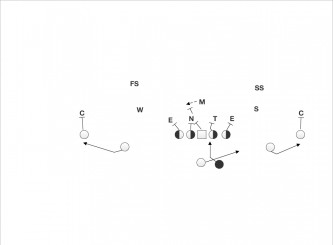
Scott Frost likes what he sees from the last play, so they run it again.
It’s an even better result this time, as the back picks up twelve yards, and a first down.
Play #5 – 1st & 10 / +43 / Right Hash

An interesting play we’ll examine closer another week…
Play #6 – 2nd & 4 / +37 / Right Middle
Not much new here except for the stacked alignments of the receivers to the outside. Scott Frost wants to press every advantage, and forcing the Buckeyes to declare with their alignment what they want to defend ends up putting only five Ohio State defenders in the box once again.
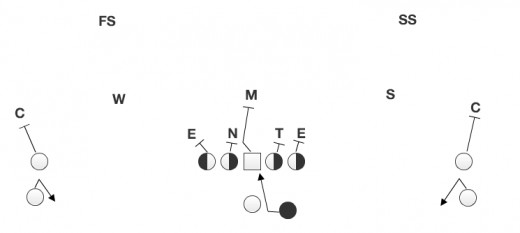
Oregon gives a similar look to the defense as the 2×2 set before, only this time the receivers on both sides are stacked, giving the defense something new to look at.
Play #7 – 1st & 10 / +31 / Left Middle
On this play, Oregon decides to motion to an empty set for the first time, and essentially turns the right side of the formation into a bunch set. The motion takes the middle linebacker out of the middle of the field, so now the Oregon staff knows they can come back to this set later on in the game if they want to run a QB draw or some kind of pass that attacks the middle of the field.
Play #8 – 2nd & 4 / +24 / Left Hash
On this play, Oregon lines up with an “attached” TE for the first time, meaning he’s not off the line of scrimmage or flexed out. This changes how the defense will align, if only slightly. It also forces the Sam LB to take seriously the perimeter run threat to that side, and puts him in conflict.

The TE releases toward the Sam LB but allows him to come inside by mistake and ends up forcing an early throw to the bubble.
Mariota manages to get the ball away, and Oregon has another first down.
Play #9 – 1st & 10 / +18 / Right Hash
On this play, Oregon lines up with an unbalanced set to the boundary, handing it off on the inside zone. The defensive line forces the RB to cut back, where the Mike linebacker is waiting for him.
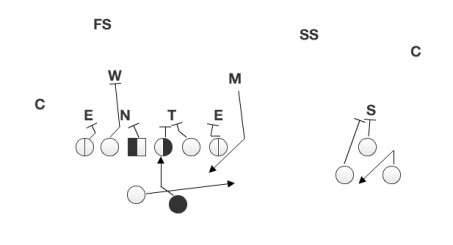 What’s important here is that not only did Oregon manage to make two yards out of essentially nothing, but also that they now have some idea of how Ohio State will line up to an unbalanced formation.
What’s important here is that not only did Oregon manage to make two yards out of essentially nothing, but also that they now have some idea of how Ohio State will line up to an unbalanced formation.
Play #10 – 2nd & 8 / +15 / Right Hash
Another example of Oregon lining up their strength to the boundary. In this case, they’re going to fake the jet sweep to the field, with Mariota keeping the ball and following the guards around the edge to pick up a first down.
The defense is expecting something back to the field in this case (like the jet sweep) because offenses will play games with formations, trying to force the defense to commit extra men to the boundary, so that they can get the ball to the wide side of the field with fewer defenders to worry about.
Play #11 – 1st & Goal / +7 / Right Hash
The final play of the drive- the scoring play- comes about for a couple of reasons.
First and most importantly, Oregon is running a concept to the two-receiver side that they’ve run probably dozens of times before. They’ve become exceptional at running what’s often referred to as a ‘switch’ route. The corner to the field side will sink and start to split the difference between the two routes once he sees the two receivers change places.
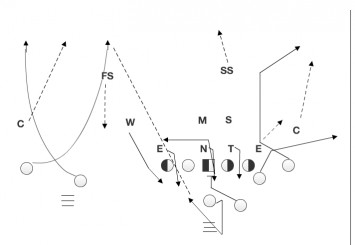
Oregon uses one of their favorite red zone concepts to put two receivers on one corner for the score.
Secondly, Mariota’s mobility inside the pocket buys time, and actually opens up throwing lanes down the field. As you can see, the free safety actually starts to come up when Mariota is scrambling around and avoiding the rush, as do the linebackers. As a result, the corner to the field side ends up defending two receivers, and the inside receiver is wide open in the middle of the field for the score.

A perfect finish to an Oregon drive…
Review and Conclusion
Let’s look back at the drive. What stands out to you?
Notice the mixture of formations used by Oregon. It’s very important for Helfrich and Frost to find out how Ohio State is going to play their different formations, as well as any personnel changes or motions.
The Ducks lined up in tight sets and wide sets. They lined up with balanced 2×2 sets and unbalanced 3×1 sets. The offense tested the defense by lining up with their strength to the boundary several times, and Ohio State had a tough time adjusting early on. The most telling stat is that Oregon never faced a 3rd down on the opening drive, which is the sign of a great plan.
Defensively, Ohio State kept it pretty simple, usually starting out with a two-deep safety look before the snap, then usually rotating one of them down closer to the line of scrimmage for run support. It also depended on the formation since against 2×2 sets, Ohio State was more likely to stay in two-deep looks.
Obviously the game did not go the way Oregon wanted it to, but the first drive was a case study in good execution by the players and preparation by the coaching staff.
I may be in Indiana, but “Oh how we love to learn about your beloved Ducks!”
Alex Kirby
Oregon Football Analyst for CFF Network/FishDuck.com
Indiana
Top Photo by John Sperry
Alex Kirby (Writer and Football Analyst) worked several seasons as an assistant football coach at the high school and college levels and is the author of Speed Kills: Breaking Down the Chip Kelly Offense, now available HERE.

